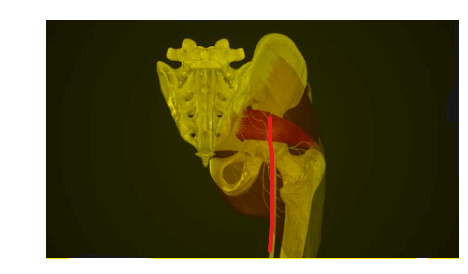Quick Overview
The superior gluteal nerve arises from the sacral plexus (a complex network of nerves located in the lower back) and innervates the gluteus medius, gluteus minimus, and tensor fasciae latae muscles.
These muscles are responsible for abducting, internally rotating, and extending the thigh at the hip joint. The superior gluteal nerve also plays a role in stabilizing the pelvis during walking and standing.

Table of Contents
Anatomy of Superior Gluteal Nerve
The superior gluteal nerve arises from the posterior divisions of the L4, L5, and S1 nerve roots of the sacral plexus. It exits the pelvis through the greater sciatic foramen superior to the piriformis muscle. The nerve then divides into two branches i,e the superior and inferior branches.
The superior branch of the SGN supplies motor function to the gluteus medius and gluteus minimus muscles. These muscles are responsible for abducting and rotating the hip joint.
The inferior branch of the SGN supplies motor function to the tensor fasciae latae muscle. This muscle is responsible for tensing the iliotibial band, which is a thick band of fascia that runs along the outside of the thigh.
| Nerve | Description |
| Origin | Sacral plexus |
| Branches | Superior branch, Inferior branch |
| Supply | gluteus medius, gluteus minimus, tensor fasciae latae |
Branches
- Superior branch
- Inferior branch
Function
The superior gluteal nerve plays an important role in hip movement and stability. The gluteus medius and gluteus minimus muscles are responsible for abducting and rotating the hip joint. These muscles are also important for stabilizing the hip joint during activities such as walking and running.
The tensor fasciae latae muscle is responsible for tensing the iliotibial band, which helps to stabilize the knee joint during activities such as running and jumping.
Associated Conditions with SGN
Understanding the potential issues related to the SGN is essential for diagnosing and managing conditions that can cause discomfort and pain in the gluteal region. Here are some of the common problems;
1- Piriformis Muscle Involvement
The piriformis muscle is another important structure in the gluteal region. It is responsible for lateral rotation of the hip joint. However, the proximity of the piriformis muscle to the SGN can lead to problems. Compression or irritation of the nerve by the piriformis muscle can result in conditions like piriformis syndrome, which can cause pain and discomfort.
2- Trendelenburg Gait and Claudication
The SGN plays a crucial role in maintaining the stability during walking. When this nerve is compromised, it can lead to a Trendelenburg gait, characterized by an abnormal gait pattern where the pelvis tilts excessively. This gait abnormality can be accompanied by claudication, which is pain or cramping in the legs during walking.
3- Sciatic Notch Issues
The sciatic notch, a bony structure in the pelvis, is also closely associated with the superior gluteal nerve. Problems in this area can affect the nerve and lead to symptoms like pain and discomfort in the gluteal region.
4- Deep Gluteal Syndrome
Deep gluteal syndrome (DGS) is a condition in which the superior gluteal nerve is compressed by other structures in the gluteal region, such as the gluteus maximus muscle or the sciatic nerve. DGS can cause pain, numbness, and weakness in the buttocks, thigh, and leg.
5- Neuro Centric Approach
The Neuro Centric Approach is a specialized method for diagnosing and treating gluteal pain and nerve-related issues. It focuses on addressing the root causes of pain and dysfunction in the gluteal region, often involving the superior gluteal nerve. This approach has shown promise in improving the quality of life for individuals dealing with gluteal pain.
Symptoms of Injury or Compression of SGN
- Pain in the gluteal region, hip joint, or thigh
- Weakness or numbness in the gluteal muscles
- Difficulty walking or running
- A Trendelenburg gait, which is characterized by dropping of the hip on the affected side when walking
Treatment
Treatment for injury or compression of the superior gluteal nerve depends on the underlying cause. In some cases, conservative treatment such as rest, ice, and physical therapy may be sufficient. However, in other cases, surgery may be necessary to decompress the nerve.
Question
Q1: What muscles does the superior gluteal nerve innervate?
The superior gluteal nerve innervates the gluteus minimus, gluteus medius, and tensor fasciae latae muscles in the gluteal region.
Q2: What is superior gluteal nerve entrapment?
Superior gluteal nerve entrapment refers to a condition where the superior gluteal nerve becomes compressed or trapped, often leading to pain and dysfunction in the gluteal area and hip region.
Q3: What is superior gluteal nerve flossing?
Superior gluteal nerve flossing is a technique used in physical therapy to alleviate symptoms of nerve entrapment. It involves gentle movements and stretches to release pressure on the nerve.
Q4: What are the roots of the superior gluteal nerve?
The superior gluteal nerve arises from the sacral plexus, which consists of nerve roots from the spinal cord segments L4 to S1.
Q5: What are the symptoms of superior gluteal nerve pain?
Superior gluteal nerve pain can manifest as buttock pain, hip discomfort, weakness in hip abduction, and an abnormal gait pattern known as Trendelenburg gait.
Q6: Are there exercises to relieve superior gluteal nerve entrapment?
Yes, there are exercises that may help alleviate symptoms of superior gluteal nerve entrapment. These exercises often focus on strengthening and stretching the muscles in the gluteal region and improving overall hip stability. However, it’s essential to consult a healthcare professional or physical therapist for a personalized exercise plan based on your specific condition.
